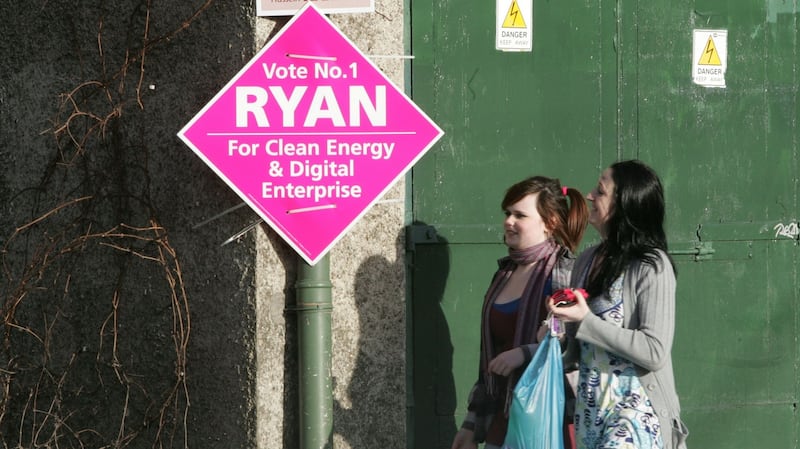The contest between Labour and the Greens as to which of them is the bigger party after the next election is likely to have an even bigger impact on the policy direction of the next government than the battle between Fine Gael and Fianna Fáil about who will lead it.
While all parties are desperately trying to get in tune with the times by committing themselves to a green agenda, and proclaiming that climate change is the great issue of the day, the Green Party has obviously better credentials on the issue than anybody else.
If they can cooperate after the next election, the Greens and Labour will be in a position to decide which of the big two leads the government. But, in the meantime, an intriguing battle between the two smaller parties is in store. The outcome will determine whether Eamon Ryan or Brendan Howlin is Tánaiste in the next government but, more importantly, it determines what that government’s priorities are going to be.
Both parties have shown great courage in taking office and implementing difficult decisions in the long-term interests of the country
Last month’s Irish Times/Ipsos MRBI poll put the Greens on 8 per cent, two points ahead of Labour. Crucially, the Greens were 13 per cent in Dublin by comparison with Labour at 7 per cent, and they were 2 points ahead of Labour in the rest of Leinster. If these figures are repeated in a general election, the Greens will win 10 seats or more and should be ahead of Labour.
Of equal significance was the fact that the Greens were also well ahead of Sinn Féin in Dublin, according to the poll. If the party can hold on to that level of support right up to the general election next April or May, it will be in a position to hoover up transfers and win a surprising number of seats in the capital.
Reverse was the case
Back in May, Labour was marginally ahead of the Greens in the local elections with both parties getting a little over 6 per cent of the vote but Labour winning more seats. The reverse was the case in the European elections with the Greens winning 11 per cent of the national vote and 2 seats compared to Labour’s 3 per cent and none.

What will stand to Labour is the party’s organisation around the country and the fact that it has survived electoral setbacks on a number of occasions over almost a century. The party’s problem coming back from the election disaster of 2016, when it dropped from 37 seats to seven, is that it faces intense competition from a range of forces – but particularly the Greens and Sinn Féin.
The Greens had their own even bigger meltdown in 2011 when the party lost all its Dáil seats following its participation in government with Fianna Fail and the tough decisions required to avert a financial disaster for the country.
While Labour and the Greens have suffered severe electoral setbacks for participating in government, both parties have shown great courage in taking office and implementing difficult decisions in the long-term interests of the country. That is what marks them out from the populist micro parties and Independents who are only interested in protest and have no commitment to governing.
Of course, both parties have been marked by their previous experience of coalition. Labour leader Brendan Howlin’s blistering attack on Leo Varadkar at his party conference last weekend was the clearest signal yet that his preference is for a coalition deal with Fianna Fáil after the next election.
Ended badly
Labour has been in coalition with Fine Gael on six occasions in his history, many of them during times of economic hardship which ended badly. By contrast it was on coalition with Fianna Fáil just once, between 1992 and 1994, and while that government collapsed in controversy most of the Labour Ministers, including Howlin, found the experience congenial.
In the end it won't be past experience or personal antipathies that will determine the shape of the next government. The vital thing will be numbers
Added to the bruising experience of being in office with Fine Gael in difficult times is Howlin’s clear antipathy towards Leo Varadkar. This is quite obvious in Dáil exchanges and was in evidence again during Howlin’s speech last weekend. By contrast, criticism of Fianna Fáil and its leader was muted to the point of politeness.
If Labour had a difficult experience in its most recent coalition with Fine Gael then the Greens had an even worse one with Fianna Fáil which led to the 2011 wipeout. Yet there is no great hostility between the two parties now, probably because they are in Opposition together and have cooperated regularly in opposing the Government.
In the end it won’t be past experience or personal antipathies that will determine the shape of the next government. The vital thing will be numbers. If Fianna Fáil has more seats than Fine Gael, or is even close to its rival, it will be in an unassailable position to put together a deal with Labour, the Greens and sympathetic Independents.
In the past Fianna Fáil has shown itself more flexible about adopting the policies of its coalition partners than Fine Gael and that could also be important. However, if Fine Gael has a significant seat advantage it will be in pole position to lead another government, regardless of other considerations. The biggest question of all may be whether it is the Greens or Labour who will call the shots.














